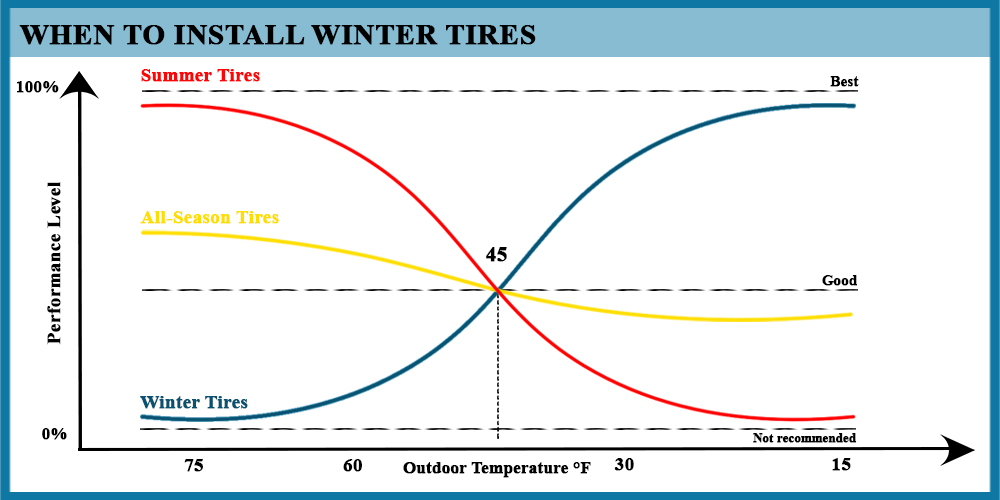Both snow and summer tires are seasonal tires. In other words, they can be used in specific months, when outside temperatures correspond to the performance they are designed for.
We often come across questions like “Can I use winter tires all year?”. While it might seem like a cost-efficient method (running just one tire set throughout the year), today we will tell you why that is a bad idea.
No, we will not be talking about the tire temperature rating, we have something else in mind. Let us guide you through why summer tires vs winter tires are so distinct.
Summer and Winter Tires Temperature Range
When it comes to winter tires vs summer tires, the most important difference between them if the temperatures they are made for:
- When to put on snow tires: when seasonal temperatures drop below 45°F
- Swap tires for summer when seasonal temperatures rise above 45°F
Quick Facts: Winter vs Summer Tire Benefits
The difference between cold-weather tires and summer models also changes their performing characteristics. Obviously, snow traction is not needed in warm weather and vice versa.
Therefore, summer tires vs winter tires are designed for specific temperatures. This affects the benefits these tires offer, which are:
- The Best Winter Tires: offer a wide range of cold-weather performance, including snow, ice, wet, and dry road surface conditions
- The Best Summer Tires: focus on warmer temperatures, dry and wet traction, as well as increased stability and improved service life
Difference Between Summer and Winter Tires
Various weather conditions require different tread elements and compound blends to ensure a safer performance. For this reason, summer tires and snow-rated tires cannot be identical.
They are designed and manufactured in order to perform in their intended weather conditions and temperatures. The distinctness lies in their tread design and rubber compound blends.

When to Use Summer Tires?
We can also rephrase the question to “when to change winter tires?” and the answer will be the same.
Summer tires are designed for warm-weather performance. In other words, when seasonal temperatures reach 45°F consistently, it is time to take off the car winter tire set.
It is important to make this change, as summer tire models use their road-to-rubber ratio to generate traction. Winter tire tread features too many sipes, which hinder traction in higher temperatures.
Therefore, you will need summer treads for high-temperature performance. Additionally, apart from excellent traction, this will also enhance the tire set’s driving stability (especially when cornering) and longer-lasting tread life.
Yet, a summer tire set should never be used in winter conditions. Winter tire installation should not be skipped, as it will ensure your safety. Summer tires will not be able to perform well in below 45°F temperatures.
When to Put On Winter Tires?
Winter driving requires good winter tires. Whether you need a light truck or car winter tire set does not change the fact that you should swap tires when temperatures fall below 45°F.
45°F is the golden rule to follow. If temperatures are constantly below this, bring out the snow treads! However, for summer tire users, that temperature range should be 50°F to ensure your driving safety.
Additionally, the time of day you drive your vehicle is also crucial. In the beginning, early mornings tend to be colder than middays – we are not saying anything new with that statement. However, what might be new information is that if you strictly drive in the mornings, you will have to change your winter tires sooner.
There are multiple reasons why this is necessary. They fall into two categories: tread design and rubber compound.
Winter tire change will allow you to use snow treads on your vehicle. These treads feature multiple biting edges and deeper grooves that brands specifically designed for ice and snow traction. Sipes provide surface grip, even on ice- and snow-covered surfaces, while the deep grooves disperse slush and snow to optimize road contact.
On the other hand, winter tires utilize special rubber compound blends. These materials keep the tires pliable in freezing temperatures, as they keep their softness and flexibility.
This also answers the question “how do winter tires work?”.
What Temperature is Too Hot for Winter Tires?
Snow tires above 50 degrees start to experience unpleasant side effects of warmer temperatures. Generally speaking, the ideal winter tire temperature range is from 45°F and lower. Summer and snow tire installation should take place when seasonal temperatures are starting to change.

Should You Use Winter Tires in Summer?
Can you drive on winter tires in the summer? Technically speaking, you can but shouldn’t.
There are different reasons why driving on winter tires in the summer is a bad idea. We have already mentioned a couple of them earlier in this article, but we will go over them again.
So, are winter tires good in summer? No, and this is why:
- Loss of Traction: Traction in snow and ice is the specialty of winter tires. When you take this away and make these models run in warm temperatures, the snow treads become useless. Their details will hinder traction and their compound will cause heat accumulation. It is not ideal for driving safety.
- Increased Tread Wear: Manufacturers design soft, flexible compounds to not freeze in harsh winters. But when it is facing above 45°F temperatures, it will cause excessive tread wear. This is because the softer rubber materials are unable to combat heat build-up along the tread area.
- Diminished Handling: Due to their lacking traction in warmer weather, winter tires can become dangerous when it comes to controllability. Drivers will not have a sharp handle over the vehicles in summer, as long as they are running winter tires. This is especially prominent during cornering, braking, and acceleration, which can also cause issues with the traction control system.
- Ruined Fuel Economy: These tires have a higher rolling resistance, which results in the vehicle needing more energy to keep the tires in motion in summer conditions. This increases its fuel intake, leading to higher gas bills.
Running winter tires in summer or year-round is not ideal. Not only will the tread depth waste away quicker, but it also has other risk factors you should keep in mind. Namely, the vehicle’s controllability and fuel economy – which can also create major issues.
Frequently Asked Questions
Can You Use Snow Tires Year Round?
Answering the “Can you use winter tires all year?” question is not simple. Yes, you can use them, but it is not recommended. This is because warmer temperatures increase their tread wear rate. Additionally, their tread patterns are for winter performance only and will hinder traction in summer weather.
How Long Do Snow Tires Last?
As long as your car winter tires are taken care of, they will last for about 3-4 seasons. However, running winter tires in warm weather will greatly reduce this number. Higher temperatures cause their compounds to wear away faster, shortening their service life even for the best winter tires.
Do Winter Tires Make a Difference?
When it comes to “Are snow tires worth it?” the answer is always yes. Winter tires use special compound blends and detailed tread designs to securely perform in cold winter weather and on ice- and snow-covered roads. Most importantly, they will provide better traction in snow and enhanced driving stability.
How Much Snow Can You Drive in?
Typically, with a good set of winter tires, you are safe to drive in up to 4 inches of snow. However, you will have to be careful of your driving habits at this point. If you own a vehicle with larger snow-rated tires, driving through 6+ inch snow will be possible.
What psi Do Snow Tires Use?
What psi your snow tires use will depend on tire type. Typically, passenger tires, including winter car tires, run at 32 to 35 psi in mild and freezing conditions. Tire brands recommend running winter tires 3-5 psi higher than normal, as the cold temperature for winter tires means losing around 1 psi/month.


